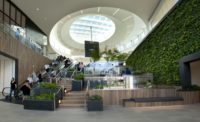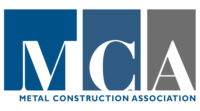As one of the largest state universities in the country, Texas A&M University was hard-pressed to expand its recreational services for its 69,000 enrolled students in College Station, Texas.
To fill the need, the new Southside Rec Center — with 63,500 square feet of indoor recreational space and 15,000 square feet of outdoor space — opened its doors in the late summer.
Earning accolades as the Metal Construction Association’s Design Awards Winner in the Single-Skin Panels category, the sleek structure features a variety of boxed ribbed metal panels, perforated metal scrim and single-skin metal panels.
“The variety of panels creates an energetic pattern across the façade, accurately reflecting the kinetic movement of the live oaks outside and the fitness activity inside,” stated Kalman Nagy, AIA, NCARB, design principal at SmithGroup in Dallas. “This varied pattern extends to other materials in the building façade, such as the vertical frit patterns on the glass and the horizontal reveals in the limestone.”
The architects designed the form as two high-bay spaces flanking a central spine where recreational activities are showcased, thereby engaging the campus at a pedestrian scale.
Metal was selected as a prominent material to complement the campus context and master plan design guidelines. For example, the dark bronze finish matches the master plan palette.
Overall, the architects successfully blend the flat composite metal panels and single-skin ribbed metal panels with a limestone and glass curtainwall exterior. Highlighting the combination of materiality and contrast between the stone and metal, the MCA judges were impressed with the detail juxtaposition and range of applications in the facility.
The team selected four different Petersen Aluminum box rib patterns in dark bronze to offset the patterns, articulating the building’s base, middle and top. While the patterns in the ribbed metal panels create texture, a change in the pattern’s rhythm emphasizes the transition from one section to the other.
A perforated box rib metal scrim, located at the main entry plaza, mimics the expression of the adjacent live oak trees. And two different profiles and perforation sizes extend the façade’s visual rhythm, shading the entry plaza and glazing of the courts and lobby.
With the ribbed metal panels extending beyond the building envelope, the cladding transitions to perforated panels to balance shading, views, texture and depth in the façade.
The single-skin metal panels also add value to the building in lending support to the outdoor amenities, including a terrace, two volleyball courts and a turf area for fitness classes and functional training. The 12-inch-wide panels stretches off the façade that enclose the large 100-foot by 200-foot high-bay for strength and conditioning and courts.
This large overhang provides shaded exterior space and daylight-protected glazing. High-performance glazing with integrated ceramic frit patterns and perpendicular shading fins further reduces heat gain while maintaining views.
Also inside the rec center is a bouldering wall, locker rooms and a cardio mezzanine. “Minimal circulation space connects a variety of programs and is a good example of a simple design move with a big impact,” Nagy said.
“It’s a shining example of the power of simplicity and how an economical and common material thoughtfully designed to work with campus context can result in a truly beautiful outcome,” Nagy stated, showcasing the modest investment required to deliver a high-quality, aesthetic building.






